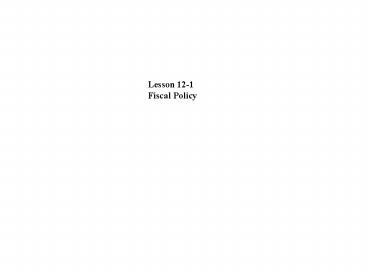Fiscal Policy PowerPoint PPT Presentation
1 / 14
Title: Fiscal Policy
1
Lesson 12-1 Fiscal Policy
2
Government and the Economy Government
Purchases Government purchases include all
purchases by government agencies of goods and
services produced by firms as well as direct
production by government agencies
themselves. The production of educational and
research services by public colleges and
universities is counted in the government
purchases component of GDP.
3
Although government spending has risen over time,
the government purchases share of aggregate
demand has declined in the past several years to
a little more than 15 percent. Federal
government purchases and state and local
government purchases have risen as a share of
GDP.
4
Transfer Payments A transfer payment is the
provision of aid or money to an individual who is
not required to provide anything in
exchange. Transfer payments by both the federal
government and state and local governments have
risen between 1960 and 1998. Government
transfer payments now constitute 13 percent of
GDP. There is a tendency for transfer payments
to rise during recessions and fall during
expansions. Interest payments rose as the
federal governments debt increased but debt
reductions in recent years have reduced interest
payments.
5
Taxes Taxes affect the relationship between GDP
and personal disposable income and there- fore
alter consumption. Taxes imposed on firms
affect the profitability of investment and
therefore the level of investment. Payroll
taxes affect the costs of hiring workers and
therefore affect employment and real
wages. Federal receipts come primarily from the
personal income tax and from payroll
taxes. State and local receipts come primarily
from property taxes and sales taxes.
6
The Government Budget Balance The governments
budget balance is the difference between the
governments revenues and its expenditures. A
budget surplus occurs if government revenues
exceed expenditures. A budget deficit occurs if
government expenditures exceed revenues. A
balanced budget occurs if government revenues
equal expenditures. The balance in a government
budget may change from zero to surplus to deficit
from changes in the economy without any policy
change.
7
The National Debt The national debt is the sum
of all past federal deficits, minus any
surpluses. The national debt as a percentage of
GDP is well below wartime levels. By
international standards, the U.S. national debt
is less than the average among developed nations.
8
The Use of Fiscal Policy to Stabilize the
Economy Basic Concepts Fiscal policy is the
use of taxes and expenditures to influence the
level of economic activity. Like monetary
policy, fiscal policy can be used to close a
recessionary or inflationary gap.
9
Automatic Stabilizers An automatic stabilizer
is any government program that tends to reduce
fluctuations in GDP automatically. An automatic
stabilizer tends to increase GDP when it is
falling and reduce GDP when it is
rising. Automatic stabilizers have increased in
importance over time. Increases in income taxes
and unemployment benefits have enhanced their
importance as automatic stabilizers.
10
Discretionary Fiscal Policy Tools Most
government expenditure and tax policies are taken
for reasons other than stabilization. The effect
on the economy is a by-product. Discretionary
fiscal policy is any change in tax or expenditure
policy that is intentionally aimed at changing
the level of economic activity. Discretionary
government spending or tax policies may be used
to shift aggregate demand. An expansionary
fiscal policy that shifts aggregate demand to the
right can be accomplished through lower taxes or
higher expenditure (purchases or transfer
payments).
11
A contractionary fiscal policy that shifts
aggregate demand to the left can be accomplished
by decreasing government expenditure (purchases
or transfer payments) or higher
taxes. Discretionary fiscal policy can be
illustrated graphically using aggregate demand
and supply analysis and the multiplier effect.
12
Changes in Business Taxes A reduction in the
corporate income tax or an investment tax credit
makes business more profitable. The goal of
such policy is to increase investment. With
increased investment, aggregate demand shifts to
the right. Increases in business taxes do just
the opposite
13
Changes in Income Taxes Changes in income taxes
affect consumption. Increased income taxes
reduce personal disposable income and therefore
consumption. Reduced consumption shifts the
aggregate demand curve to the left. Reductions
in the income tax do just the opposite. Changes
in Transfer Payments Decreased transfer
payments do just the opposite
14
Changes in transfer payments affect
consumption. Increased transfer payments
increase personal disposable income and therefore
consumption. Increased consumption shifts the
aggregate demand curve to the right.

